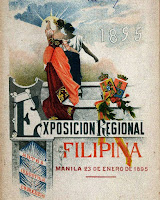Note: This photo-essay is in the 'living' section of the 19-25 June 2015 issue of FilAm Star, the weekly 'newspaper for Filipinos in mainstream America published in San Francisco, CA. This author/blogger is the Manila-based special news/photo correspondent of the paper.
As prelude to our personal observance of the 117th anniversary
of Philippine Independence, we pored through the Propaganda exhibit at the
Lopez Museum & Library, and listened to historian Ambeth Ocampo’s discourse
on “(A)lamat at (H)istorya sa Paghahanap ng Kalinangan ng Sinaunang Filipino” during
the inaugural Lekturang Norberto L. Romualdez
of the Komisyon ng Wikang Filipino (KWF) at the Court of Appeals auditorium
in Manila.
“Propaganda” immediately brings to mind patriotic
Filipino expatriates in Spain who fought for reforms in their native land
through their fortnightly newspaper La Solidaridad (Sol), which they published
in Barcelona and Madrid for almost seven years, from February 1889 to November
1895.
 |
| Picture from the Biblioteca Nacional de Espana. Juan Luna painting can be seen at the Lopez Musuem & Library. |
Juan Luna expressed the vision of the reformist
ilustrados in his España y Filipinas, which he painted in 1886. The Lopez
Museum & Library has a copy of this painting that shows a woman in red classical
dress (Spain) holding a lady in white baro and blue saya (Philippines) by the
waist, and leading her toward a bright
horizon as they ascend a staircase strewn with flowers.
This painting was adapted by the Spanish colonial
government as the cover illustration of the catalog of the Exposicion Regional
Filipina held in Manila in 1895 to showcase the social, cultural and economic
activities in the colony. Propaganda indeed for Spain guiding her colony to a
bright future!
The revolutionary movement that came also had its own
propaganda press to spread cause for independence from Spain to the Filipino
masses. The Katipunan propagated its ideals through the writings of Andres
Bonifacio and Emilio Jacinto in the Kalayaan, their newspaper in Tagalog. Thus,
the Katipunan gained many adherents in the provinces in Southern and Central
Luzon.
After Kawit 1898, the new republic also needed propaganda
media to get the respect and recognition of foreign powers and to announce the
nation’s aspirations. Its official organ (1898-1899) published the decrees of
the government and patriotic literature. The most famous propaganda paper was
edited and privately owned by Gen. Antonio Luna: La Independencia. When the
Aguinaldo was on the run from the Americans, so was La Independencia with its
few fonts of type, and its old Franklin handpress, packed into a carabao cart.
 |
Propaganda exhibit:at the Lopez
Museum &; Library:
La Independencia of 25 December 1898.
|
With the onset of peacetime in the American colony, the
Filipinos began exercising their new freedoms, particularly freedom of speech. The famous “Aves de Rapina” libel case of 1908
was brought about by attacks on the Secretary of the Interior Dean Worcester in
the nationalist paper El Renacimiento.
The publicity campaigns of the Philippine Press Bureau in
Washington greatly helped the Philippine missions for independence to the
United States from 1919 to 1924. The campaigns were intended to develop the interest
of the U.S. Congress and the American public in the Philippine issue. A privately owned monthly magazine, The
Philippine Republic (1924-1928) publicized the independence agenda and played
up achievements of Filipinos here and those in the United States to highlight
their capabilities for self-government.
 |
| Picture from the Lopez Musuem & Library. |
Japanese counter-propaganda in various media vis-a-vis
Isip’s Fighting Filipino are on exhibit at the Lopez Museum. Among these are
posters hyping on the Asian co-prosperity sphere, movie posters glamorizing
Philippine-Japanese partnerships, and cartoons depicting happy relationships
between the masses and Japanese soldiers.
Up on the walls too are the editorial cartoons of
Gatbonton in the pre-martial law Manila Chronicle. These are drawn commentaries
relating usually to current events or personalities. Gat’s cartoons on our election system and
Filipino politicians remain relevant today as ever.
Woven into the Propaganda exhibit are artworks in the
museum collection done by our famous 18th century masters, national artists,
and contemporary artists.
The Merriam-Webster dictionary defines propaganda as
“ideas, facts, or allegations spread deliberately to further one's cause or to
damage an opposing cause; [and] also a public action having such an effect.”


No comments:
Post a Comment